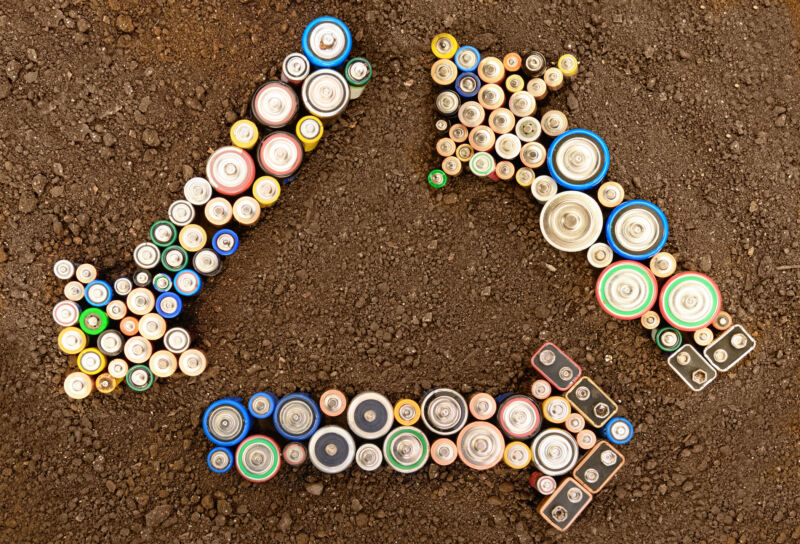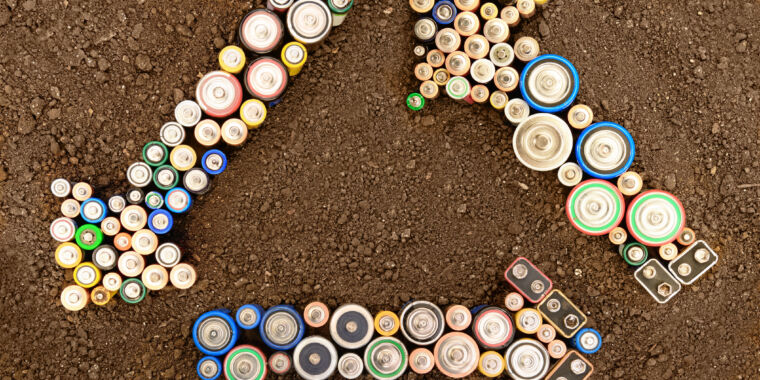
Earth Day is April 22, and its usual message—take care of our planet—has been given added urgency by the challenges highlighted in the latest IPCC report. This year, Ars is taking a look at the technologies we normally cover, from cars to chipmaking, and finding out how we can boost their sustainability and minimize their climate impact.
Electric vehicles, power tools, smartwatches—Lithium-ion batteries are everywhere now. However, the materials to make them are finite, and sourcing them has environmental, humanitarian, and economic implications. Recycling is key to addressing those, but a recent study shows most Lithium-ion batteries never get recycled.
Lithium and several other metals that make up these batteries are incredibly valuable. The cost of raw lithium is roughly seven times what you’d pay for the same weight in lead, but unlike lithium batteries, almost all lead-acid batteries get recycled. So there’s something beyond pure economics at play.
It turns out that there are good reasons why lithium battery recycling hasn’t happened yet. But some companies expect to change that, which is a good thing since recycling lithium batteries will be an essential part of the renewable energy transition.
Lead-acid lessons
How extreme is the disparity between lithium and lead batteries? In 2021, the average price of one metric ton of battery-grade lithium carbonate was $17,000 compared to $2,425 for lead North American markets, and raw materials now account for over half of battery cost, according to a 2021 report by the International Energy Agency (IEA).
The imbalance of recycling is counterintuitive in terms of fresh material supply as well. Global sources of lithium amount to 89 million tons, most of which originate in South America, according to a recent United States Geological Survey report. In contrast, the global lead supply at 2 billion tons was 22 times higher than lithium.
Despite the smaller supply of lithium, a study earlier this year in the Journal of the Indian Institute of Science found that less than 1 percent of Lithium-ion batteries get recycled in the US and EU compared to 99 percent of lead-acid batteries, which are most often used in gas vehicles and power grids. According to the study, recycling challenges range from the constantly evolving battery technology to costly shipping of dangerous materials to inadequate government regulation.
Emma Nehrenheim, chief environmental officer at Northvolt batteries, said everyone expected lead to be phased out by now, but she attributes its continued economic success to high recycling rates.
“Every time you buy a battery for your car, you have to give the whole battery back, and then it goes into the recycling chain,” said Nikhil Gupta, lead author of the study and a professor of mechanical engineering at the Tandon School of Engineering at New York University. This hasn’t worked for lithium batteries, partly because so many formats exist. “These batteries are all over the place in different sizes,” he said. A related challenge is that the technology for lithium batteries changes rapidly — every one to two years, he said.
But overcoming these recycling challenges is a must. Lithium-based batteries hold more energy in a smaller package when compared to lead-acid batteries. They’re crucial for decarbonizing transportation and enabling a widespread transition to renewable energy by helping ensure a predictable supply of power from otherwise intermittent wind and solar. Achieving these transitions on a global scale is a massive undertaking. “That would require us to make major advancements in battery technology,” Gupta said. “There’s no doubt about it.”
Accordingly, global lithium consumption has increased 33 percent since 2020. If renewable energy goals sufficient to stop climate change are to be reached, then the demand for lithium is expected to grow 43-fold, according to the IEA. “What happens if we don’t have a lithium supply?” Gupta said. “There’s no good answer yet.”
Lithium isn’t the only material that may limit the use of these batteries. The anode and cathode of the batteries contain materials that are also subject to potential supply crunches, like cobalt and nickel. So, recycling could help solve multiple supply issues. “If you want to build a battery, an old battery contains exactly the same components,” Nehrenheim said.








